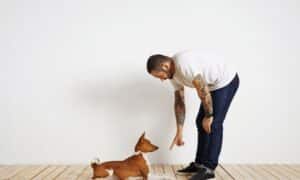“This post contains affiliate links, and I will be compensated if you make a purchase after clicking on my links.”
So your dog “Fido” is not responding to the training methods you are using and you assume he or she is a bit stupid. While it is normal to assume this is the case, what many dog owners should understand is, there are actually four ways a dog learns. How dogs learn or don’t learn is going to depend on the breed of dog and your skill as a trainer. A basic concept to all learning is called operant conditioning, and that is recognizing and working within the 4 ways that dogs learn. Understanding effective dog training requires knowledge on your part that there are consequences to certain behaviors. How dogs learn using one of the four accepted training methods will entail the dog learning there are consequences to his behaviors.
How dogs learn
Just as with all animals positive reinforcement of a dog’s behavior is going to result in more of the same. Punishing undesirable behavior in your dog is going to decrease this behavior. A very important key to keep in mind when using operant conditioning is that “punishment” dog training is withholding something, not actual physically harming the dog. We do NOT condone that type of training under any circumstances! Positive training is giving a reward for the correct behavior. These rewards and punishments can include but not be limited to favorite treats, toys, praise or scolding, and attention. The four techniques for teaching your dog to learn are listed below.
A good overview of “operant training” is given in the following eHow.com article:
Operant conditioning is also known as training an animal with consequences. There are both positive and negative consequences and with proper training, a dog knows what to expect. Although this type of training uses punishment as a way to get a dog to behave, the punishment doesn’t inflict pain in any way. Operant conditioning is the humane way to train your dog.
Here are the four ways the dog learns:
1) We are teaching our dog to stay. You give the command and he stays while you walk a short distance away. When ask to come to you he does and the result is he gets praise, a favorite treat or a few minutes of play time. This is positive reinforcement training and a great example of how dogs learn what you are teaching. Repetition of this training technique teaches your dog he or she will receive something they enjoy and increase the occurrence of the desired behavior.
2) On the other hand we can use positive punishment to decrease and eliminate any undesirable behaviors our dog is exhibiting. Training with this method teaches the dog that not listening to your commands results in an unpleasant response from you he will not like. A
3) Negative reinforcement would be when you watch your dog do something he knows not to do and you do not scold him, he will learn it is ok to continue this undesirable behavior because there is not going to be any punishment for doing so. A good example is when a puppy grabs one of your shoes to chew on, and you just sit there and let him.
4) The last method concerning how dogs learn is by negative punishment. This is where you take away something from the dog for his or her bad behavior. A very common example of this is a “time-out” period where your attention to the dog is withheld.
I have found that the positive rewards works best with my dogs over the years, but I do not reward the dog every time. At first when training a puppy, I use treats, but quickly start tapering them off and substitute praise and play time. Then I start tapering those way off as the dog responds properly. But usually a balanced mix works best, because the dog will have behaviors that you may want to exhibit displeasure with immediately, such as jumping up on people. It will probably take a little experimenting to find the best combination, and which one seems to work best for the dog. How dogs learn is not complicated if you use good sense and learn what to do before attempting to teach your dog.
What experiences have you had with teaching your dog? Comments are welcome below.



















